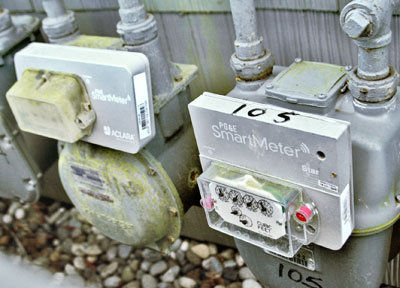
Pacific Gas & Electric Co. customers in Santa Cruz County received certified letters by way of the U.S. Postal Service last week describing the fees they would pay to opt out of the widespread Smart Meter program.
PG&E notified customers following a Feb. 1 decision by the California Public Utilities Commission that it would charge a $75 one-time setup fee and a $10 monthly meter-reading charge for all customers who keep their traditional analog meters, rather than switch to wireless Smart Meters at no charge. Customers must respond by May 1 to opt out, according to PG&E.
Those notified were all on the Smart Meter Delay List — customers who had requested PG&E delay the installation of the wireless meters while the utilities commission decided on the specifics of the opt-out program.
Santa Cruz County Supervisor Neal Coonerty, who represents most of Bonny Doon and part of Santa Cruz, said he had heard from many residents on the topic of Smart Meters, most recently about the new fees.
“They’re mostly unhappy about the cost of opting out,” Coonerty said. “They feel it’s unfair and punitive and makes it more difficult to refuse the Smart Meter.”
Coonerty said he thought PG&E could eat the cost of keeping analog meters and sending employees to read them.
“(The fee) seems like a way to discourage people from opting out,” he said. “They seem like a labor-saving device for (PG&E).”
Scotts Valley’s Joshua Hart, head of watchdog stopsmartmeters.org, contends that the decision was made by a regulatory agency that wants to protect the Smart Meter program, despite 49 local California governments passing moratoriums or opposing the change.
“The real reason for the opt-out fee is not to cover PG&E’s costs — it’s simply to encourage people not to opt out,” Hart said.
A PG&E customer service representative explained this week that the fee would pay for a worker to check that an existing analog meter was in working condition. A sticker would then be placed on the meter to notify other workers to skip installing a Smart Meter in its place.
The utilities commission ruled that PG&E must monitor the costs associated with the opt-out program and could charge more if costs were higher than anticipated — or refund customers’ money if costs were lower.
PG&E assumed 145,800 customers would opt out in the study done for the California Public Utilities Commission. The company estimated to the commission that opting out would cost the company $416 per customer, a number far below the $75 fee the CPUC agreed PG&E could charge customers. The actual cost will depend on how many customers opt out.
Smart Meter debate heard by commission
The California Public Utilities Commission heard from Smart Meter opponents and proponents before ruling on the opt-out details.
Included in the hearing were people who opposed the meter because of radio-frequency emissions, as well as those who complained about the accuracy of the meters and the prohibitive cost of opting out to low-income or fixed-income families.
PG&E argued in favor of the meter and offered different opt-out scenarios. The company preferred to use a Smart Meter with the radio turned off as the alternative, rather than keeping an analog meter.
Stopsmartmeter.org’s position, Hart said, is that Smart Meter technology can cause long-term damage to the brain, DNA and other parts of the body. He recommends that people opt out, don’t pay the fee and do anything they feel they need to keep their analog meter.
“The bottom line is people need to take care of their own safety,” he said.
The PUC, however, cited several studies that deemed the devices safe.
Hart also recommends keeping $75 on hand in an account as a safeguard.
The commission ruled that income-qualified families under the California Alternate Rates for Energy program would pay a reduced $10 opt-out fee and $5 monthly fee.
The commission still ruled in favor of the digital technology as a way to manage California’s energy supply, reduce greenhouse emissions and manage future power plant development costs, however.
“We remind parties that while we believe that residential customers should be offered an opportunity to opt out of receiving a wireless Smart Meter, the selected option should not impede state energy objectives,” commissioners wrote in the Feb. 1 ruling. “As such, it is important that the selected opt-out option has the capability to allow customers to take advantage of smart grid benefits in the future.”
The Smart Meter collects gas- and electricity-use data and transmits it every 15 minutes by way of radio frequency to a network access point. The access point aggregates the information and sends it to PG&E by way of a cellular signal.
The constant readings allow customers to view their use hour by hour and also allow PG&E to charge different rates during peak-use hours, which fall during weekday afternoons.
How to opt out:
- Go to www.pge.com/smartmeteroptout.
- Call 866-743-0263.











